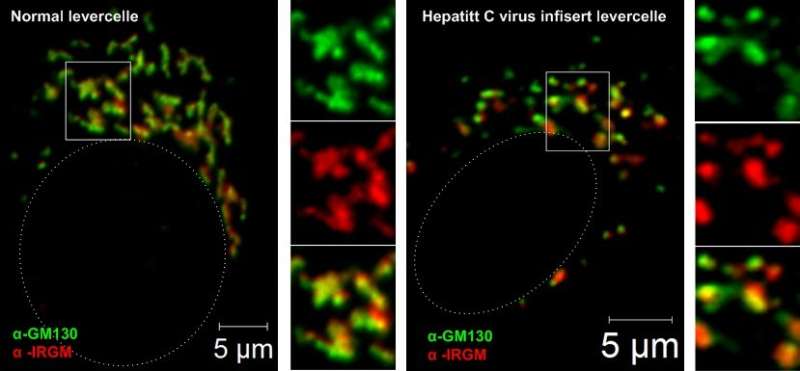How hepatitis C hides in the body

The Hepatitis C (HCV) virus is a sly enemy to have in one's body. Not only does it manage to make itself invisible to the immune system by breaking down communication between the immune cells, it also builds secret virus "factories" that quickly go into mass production.
It takes one to three months from infection to disease, which in the worst case scenario can lead to liver failure and death over time.
After an intense hunt, researchers at the Norwegian University of Science and Technology (NTNU) can now describe an important part of the disease's guerrilla tactics: how hepatitis C converts innocent cells into outright virus factories.
Can last a lifetime
According to Marit Anthonsen, a professor at NTNU's Department of Laboratory Medicine, Children' and Women's Health, "the hepatitis C virus is transmitted through blood and infects the cells in the liver, but it's not always easy to detect. Often, you have no symptoms when you get infected, so many people are carrying the virus without being aware of it."
"In most infected individuals, the virus will cause a chronic infection that lasts a lifetime. It may take decades before the infection leads to liver failure or cancer, so a lot of people are unaware that they have the virus in their body. They only notice it when they get seriously ill, which may be too late for the treatments that are available today," Anthonsen says.
Poorly understood for a long time
Until recently, researchers weren't able to keep the hepatitis C virus alive in the laboratory and thus knew very little about the virus's replication strategies in the liver. The discovery of how to grow HCV in liver cells in 2006 was a milestone. Researchers found that the hepatitis C virus actually destroys important proteins in the immune system to promote its own growth. The ability to directly manipulate their host cells is the reason some viruses are very harmful to us.
Our cells have a complex inner structure that is divided into different areas, with different "sacs" that are formed from fatty membranes. It has long been known that viruses having the same genetic material as HCV (positively polarized single-stranded RNA) cause major changes in these membrane sacs.
As part of her PhD project in Anthonsen's research group, Marianne Doré Hansen observed that liver cells infected with HCV had altered membrane sacs. The research group wanted to find the tools that the hepatitis C virus uses to create these changes.
The researchers became interested in the protein IRGM, which has been shown to produce membrane changes, similar to what they were observing, for the tuberculosis bacterium Mycobacterium tuberculosis, the measles virus and HIV.
To study whether the IRGM protein caused the changes, they employed the CRISPR-Cas system, a technique that is being used more and more often for regulating cells, in this case to turn off the IRGM protein in the liver cells.
What happens if we turn off this protein?
When the IRGM is removed from the liver cells, the virus is unable to grow. The reason for this is that the hepatitis C virus utilizes some of the cells, called the Golgi apparatus, where the protein IRGM has an important function. The Golgi apparatus is a kind of transport centre – akin to a post office – in the cells. It packs proteins into small sacs (vesicles) and sends them where they need to go within the cell, or out to other cells.
The hepatitis C virus utilizes this to build its virus factories by taking over the post office and redirecting these vesicles with the necessary building blocks to the site where the factories are being built. These vesicles are rich in lipids that the virus is entirely dependent on to anchor its factory construction.
When this protein is removed, the virus is no longer able to infiltrate the Golgi apparatus and thus it can't build up its secret network of virus factories.
A "forgotten crisis"
An alarming increase in newly HCV-infected persons is occurring worldwide. Doctors Without Borders has described hepatitis C as a forgotten crisis. In Pakistan alone, 657 people become infected every day.
The Norwegian Directorate of Health estimates that three per cent of the world's population, or about 185 million people, are infected with HCV.
In Norway, 20,000-30,000 people carry the virus. Hepatitis C is transmitted via the blood. Infection is spread primarily through unclean syringes, non-sterilized medical devices, or unsafe blood transfusions. HVC can also be passed on from mother to child, and through bodily fluids.
Medicines more costly than diamonds
As of today, no vaccine exists for the hepatitis C virus. The medicines that are on the market are expensive and not 100 per cent effective for all types of hepatitis C. Gram for gram, medications that cure hepatitis C infections are more expensive than diamonds.
Researchers hope that their discovery may in the long run lead to developing new, cheaper medicines that will enable all people infected with HCV to be treated.
It is also critical to increase our understanding of the strategies viruses use to outwit us. The knowledge gained from this study may also help in learning about other viruses that infect the liver.
The discovery may offer important clues for understanding how cancer develops in the liver and intestines. The protein IRGM influences several inflammatory processes associated with cancer outside the liver. Bacteria and viruses affect how diseases develop in the intestines as well.
More information: Marianne D. Hansen et al. Hepatitis C virus triggers Golgi fragmentation and autophagy through the immunity-related GTPase M, Proceedings of the National Academy of Sciences (2017). DOI: 10.1073/pnas.1616683114


















